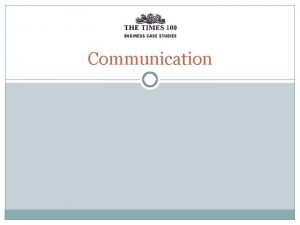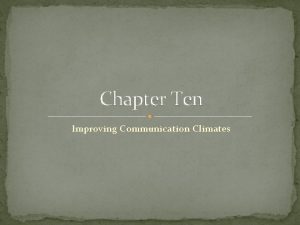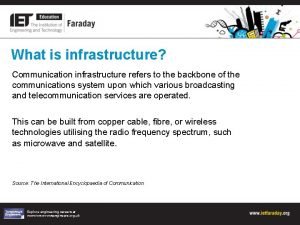Communication What is communication Communication refers to the








- Slides: 8

Communication

What is communication Communication refers to the transmission of information from a sender to a receiver, via a given medium. Two-way communication involves some kind of feedback from the receiver back to the sender.

Importance of effective communication Effective communication is necessary for: Business decision making – without the relevant information decision making can be hindered Motivating workers – team-working, praise and recognition all require clear communication for example Co-ordinating the activities of organisations Promoting an organisation and its products, services and brands

Methods of communication Within businesses a huge range of information is communicated using a range of methods e. g. The financial performance are communicated through formal, written reports Instructions are passed through face-to-face conversations Orders are sent via email Future plans are introduced using presentation software Warnings are given using signage and images

Classifying communication Verbal e. g. face-to-face and telephone conversations. Understanding may be checked straight away and body language may be used, but there is no permanent record of the communication for future reference Written e. g. letters and emails. Written communications can be kept and re-read if necessary however meaning can sometimes be misconstrued as it is not possible to check understanding or convey any body language Visual/Images e. g. signs and posters. Visual communications may have more impact than written messages.

Classifying communication Internal communication – occurs within the firm e. g. between the marketing and finance departments External communication – occurs between the firm and someone outside the business e. g. with a customer or supplier Formal communications – these use methods which are officially recognised by the organisation e. g. the weekly newsletter, letters and reports Informal communications – these methods are not officially recognised e. g. a chat by the water cooler

ICT & Communication The use of information and communications technology (ICT) has grown in businesses. Examples include: Email Graphics software Word processing Presentation packages Internet and intranet

ICT & Communication Advantages Disadvantages • Presentations and reports can be more professionally produced • Information can be passed on quickly and to a large number of people • ICT allows employees to work in alternative places e. g. at home, on the train • Workers may be more productive because communication is quicker • Risk of information overload • Technology is expensive to implement initially • Training may be needed to use the ICT • Maintenance is required • Security issues of storing personal and bank details • Health and safety issues of using computers and VDUs















